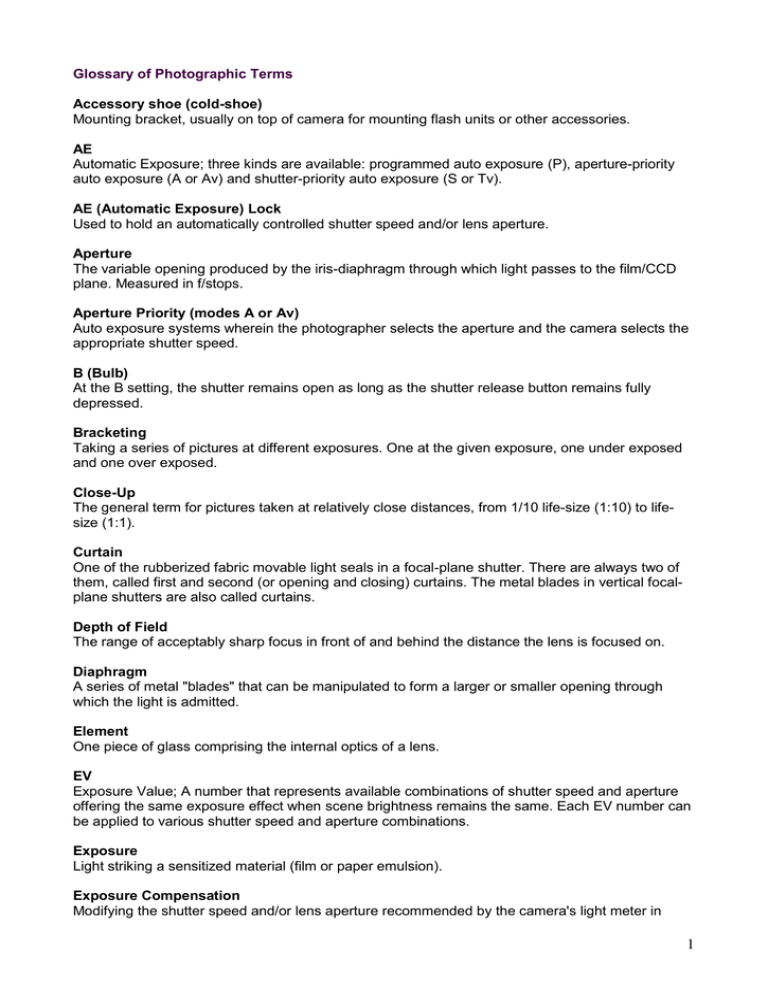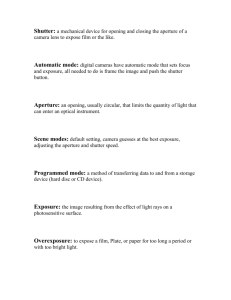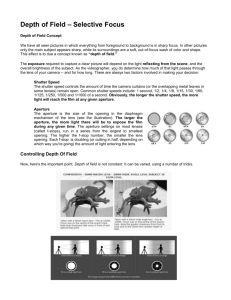Glossary of Photographic Terms
advertisement

Glossary of Photographic Terms Accessory shoe (cold-shoe) Mounting bracket, usually on top of camera for mounting flash units or other accessories. AE Automatic Exposure; three kinds are available: programmed auto exposure (P), aperture-priority auto exposure (A or Av) and shutter-priority auto exposure (S or Tv). AE (Automatic Exposure) Lock Used to hold an automatically controlled shutter speed and/or lens aperture. Aperture The variable opening produced by the iris-diaphragm through which light passes to the film/CCD plane. Measured in f/stops. Aperture Priority (modes A or Av) Auto exposure systems wherein the photographer selects the aperture and the camera selects the appropriate shutter speed. B (Bulb) At the B setting, the shutter remains open as long as the shutter release button remains fully depressed. Bracketing Taking a series of pictures at different exposures. One at the given exposure, one under exposed and one over exposed. Close-Up The general term for pictures taken at relatively close distances, from 1/10 life-size (1:10) to lifesize (1:1). Curtain One of the rubberized fabric movable light seals in a focal-plane shutter. There are always two of them, called first and second (or opening and closing) curtains. The metal blades in vertical focalplane shutters are also called curtains. Depth of Field The range of acceptably sharp focus in front of and behind the distance the lens is focused on. Diaphragm A series of metal "blades" that can be manipulated to form a larger or smaller opening through which the light is admitted. Element One piece of glass comprising the internal optics of a lens. EV Exposure Value; A number that represents available combinations of shutter speed and aperture offering the same exposure effect when scene brightness remains the same. Each EV number can be applied to various shutter speed and aperture combinations. Exposure Light striking a sensitized material (film or paper emulsion). Exposure Compensation Modifying the shutter speed and/or lens aperture recommended by the camera's light meter in 1 order to produce special creative effects or to meet special requirements. f-stop 1. The size of aperture expressed as the ratio of focal-length over diameter. 2. The actual figures used in practice, such as 2.8, 4. 5.6, etc.. Fill-Flash Exposure consisting of a combination of flash and "available light" balanced to produce a pleasing mix of the two. Fisheye An ultra-wide angle lens which purposely introduces barrel distortion so straight lines near the edges of the frame appear to curve out. Flare Image degradation caused by stray light which passes through the lens but is not focused to form the primary image. Often caused by light bouncing off internal air-to-glass surfaces. Focal Length The distance from the optical centre of a lens to the image plane when the lens is focused to infinity. Hot Shoe A mounting device, usually built onto the top of a camera, that enables a flash unit, or speed light, to be mounted on and triggered by the camera. Hyper-focal Distance The distance setting on a lens which affords the maximum depth of field for a given aperture (f/stop). The closest point of focus where the depth of field includes infinity. ISO International Standards Organization; the number represents the film or CCD sensitivity to light. A higher ISO number indicates the film or CCD is more sensitive and requires less light for a proper exposure. Latitude The variance from "proper" exposure which will still provide acceptable results. LED (Light Emitting Diode) Used as indicator light or read-out. Often red, but can be green or yellow. Lens speed The maximum aperture of a lens. Light meter Exposure meter Matrix Auto exposure metering where the camera sets both aperture and shutter speed according to data stored in the camera's built-in memory, comparing the scene to be photographed to reference scenes. Macro Focusing Macro focusing, applied to zoom lenses, moves the lens group(s), enabling the lens to focus closer than the normal focusing distance from close-up shooting. 2 Micro The picture-taking range from life-size (1:1) to 50X (50:1) magnification. Resolution The ability of a lens or photographic material to reproduce small details; measured in lines per millimetre or pixels x inch. RF (Rangefinder) Usually refers to an optomechanical device built into a rangefinder camera as a focusing aid. Shutter Device to let a controlled amount of light reach the film or CCD. Focal-plane, lens-shutter, behind the lens are all shutter types. Shutter Priority (S or Tv) Auto exposure systems wherein the photographer selects the shutter speed and the camera selects the appropriate aperture. Shutter-speed The length of time the shutter stays open for exposure. Single-Lens Reflex (SLR) A camera configuration whereby both viewing the scene and taking the picture is effected through the same lens. The system utilizes a mirror to reflect the image into the viewfinder optics during the viewing phase. In most systems, the mirror flips out of the way during exposure. Some cameras have a stationary two-way mirror. Stop 1. The difference of one (1) in the EV value. 2. The amount of offset on any of the control dials that produces a difference of one in the EV value (often, one physical click-stop). T (Time) At the T setting, the shutter remains open until, for example, it is closed by rotating the shutter speed dial, etc. TTL Through The Lens; viewing (or more commonly metering) through the picture-taking lens. Viewfinder (VF) 1. Optical device to show the photographer the area being photographed. 2. A camera having separate viewing optics — not a reflex camera. 3. The screen, pentaprism and eyepiece in a SLR camera. Working Distance The distance from the front of the lens surface to the subject. The more frequently used term "shooting distance" refers to the distance between the subject and the film or CCD plane. Working distance is most often used in close-up photography, especially when shooting a shy subject, such as an insect, or when the lens may hamper lighting. X-sync The maximum (fastest) shutter speed at which electronic flash pictures may be taken. Zoom lens Variable focal-length lens. 3


